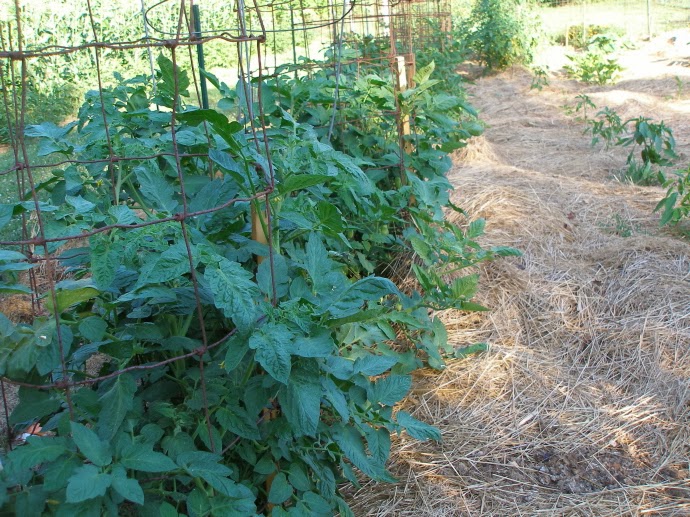As you're planning your garden, consider these different methods if you're not pleased with your current one.
Cages
This is the method we were most familiar with seeing other people use. So when we started our first garden here, it's what did, too. We found old fencing and cages in an old brush pile out back and Jamey pliers-ed them into shape. Some of it was rabbit fencing which meant the openings in the bottom were smaller than up top. This made picking the lower tomatoes a bit difficult for me since my arms are (evidently) on the short side. Sometimes the stakes or cages would either blow over or fall over under the weight of the large tomato plants. Sometimes we failed to space them far enough apart (trying to save valuable garden space) and this made squeezing between the cages/plants without knocking them over a challenge. Having the tomatoes behind bars, so to speak, made pruning them difficult, so we didn't do it- which may have lead to the smaller tomatoes we grew. They became bushy but generally stayed healthy. Overall, it worked fine and we grew lots of tomatoes.
The Florida Weave
Then we heard about the Florida Weave- a method that our vegetable farmer friend uses. We were intrigued and looked it up. You can read a detailed post about how we did it here. We loved the idea of getting rid of the cages, supporting the plants better and having easier access to the fruit. Adding levels of twine as the plants grew was an added chore, but not a big deal. We used this method for a couple years and grew lots of tomatoes once again.
Last year, we read Herrick Kimball's Idea Book for Gardeners. He prefers trellising his tomato plants. This method has a lot in common with the Florida Weave in that the cages are gone and the tomatoes can be easily harvested. Instead of using twine, the plants are trained up fixed fencing- we used cattle fencing (or feedlot paneling) which is very rigid. With this technique, as the plant grows taller, the tip is gently woven in and out of the fencing. A tomato plant won't train up by itself (like peas) but helping it train keeps them well supported. Kimball also goes into detailed instructions on the proper way to prune tomatoes- something we never did much of. This opens up the plant to light and air and sends more energy to the fruit (much like any other pruning). Once again, we grew lots of tomatoes.
We were happy with this method as well and liked it a bit more than the Florida Weave because we didn't have to mess with twine (not that it's a real bother). We're planning on using this method again this year.
If you've noticed, with all of the methods we've used, we've grown lots of tomatoes. We can't help but think that mulching has something to do with this. It keeps the moisture levels more constant, something tomatoes (and all plants for that matter) enjoy.
That is, until we hear of another fun method to try:-). Pin It

























Hi Jane,
ReplyDeleteVery nice. Thanks for mentioning my garden Idea Book.
I'm wondering if you have discussed tomato varieties you grow and the ones you like best, or that grow best on the T-post trellis spans (with fencing and large openings to weave the growing plants)?
Herrick Kimball
I use the trellising technique after caging for many years. The only tomatoes I cage (and I use the rebar panels to make them) are my cherry tomatoes and big slicers which I grow in barrels. The rest of them go on the trellis with grass clipping mulch and we've had great success with that technique.
ReplyDeleteI've used all three methods too. I gave up cages after last year. Florida Weave is by far my favorite. My tip to you is to do the twine weaving the day you put the stakes in. That way plants aren't in your way. It takes under 10 minutes. Then as the plants grow, I just tuck them in between the twine. It worked great for me last here. Here's a blog post I did about the method: http://www.preppypinkcrocodile.com/2013/07/florida-weave-tomato-staking-method.html
ReplyDeleteI trellis at my house (city home- tiny yard) against a brick wall. That actually is by far my best method however I can only grow about five plants if I squish them in that space. But the combo of the brick holding the heat at the back and the trellis cattle wire in the front is magic.
I'm starting my seeds this week!! You know...as another snow storm comes to town. So ready for spring to get here.
KK
I thought I replied yesterday, but my computer was acting funny and must not have worked. Thanks for posting about this. The main argument I see against trellising and pruning is that there is a decrease in actual tomatoes. Did you find that true?
ReplyDeleteI'm pretty sure we planted close the same amount of plants and felt like we got only slightly less tomatoes in number, but the size of them was better (larger). We also likely didn't prune as hard as some do/would advise. So much comes into play here- the variety, the weather, etc. Even the same habits two years in a row can produce different outcomes.
DeleteI do the Florida weave as well, and have been very pleased with the method and results. And like Preppy Pink Crocodile (don't you love that name!?!?), we do all our twine when the stakes go in. So much easier! Great posting!
ReplyDeleteWe still cage. I feel so outdated now!
ReplyDeleteWe do fencing for the big eating varieties, with occasional tying up and plenty of pruning - especially at their bases. I normally leave the paste tomatoes on the ground (with mulch under them), as that is how they do best.
ReplyDelete